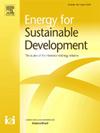Unlocking the green economy in Guyana: Leveraging agro-industrial residues for sustainable energy and carbon mitigation
IF 4.9
2区 工程技术
Q2 ENERGY & FUELS
引用次数: 0
Abstract
This paper explores the untapped potential of biomass residues from Guyana's three primary agro-industries - forestry, rice, and coconut - as a renewable energy source. We argue that converting these ‘low-value’ residues into torrefied pellets can diversify Guyana's energy portfolio, mitigate environmental impacts, and serve as a reliable energy source for marginalized communities. This initiative supports the Low Carbon Development Strategy 2030, the national overarching policy for sustainability. By unlocking the green economy, Guyana not only stands to reduce CO2 emissions significantly but also sets a precedent for sustainable development through renewable energy. Three major agro-industries collectively generate 246,261 MT of biomass residue annually, with a thermal energy potential of 161,659 GJ. The rice sector leads in potential thermal energy and total mass, offering a substantial resource for renewable energy. The rice sector is also the largest contributor to CO2 emissions in Guyana across all combustion levels, emitting over five times more CO2 than the forest sector and over ten times more than the coconut sector at 100 % combustion. This study reveals that managing combustion levels and converting biomass residues into energy pellets can significantly reduce CO2 emissions across the three primary industries in Guyana, thereby contributing to carbon mitigation.
释放圭亚那的绿色经济:利用农工业残留物促进可持续能源和碳减排
本文探讨了圭亚那三个主要农业产业——林业、水稻和椰子——的生物质残留物作为可再生能源的未开发潜力。我们认为,将这些“低价值”残留物转化为碳化颗粒可以使圭亚那的能源组合多样化,减轻环境影响,并为边缘化社区提供可靠的能源。该倡议支持《2030年低碳发展战略》这一国家可持续发展总体政策。通过放开绿色经济,圭亚那不仅有望大幅减少二氧化碳排放,而且还将开创通过可再生能源实现可持续发展的先例。三大农业产业每年总共产生246,261吨生物质残渣,热能潜力为161,659 GJ。稻米部门在潜在热能和总质量方面处于领先地位,为可再生能源提供了大量资源。在圭亚那,水稻部门也是所有燃烧水平二氧化碳排放的最大贡献者,其二氧化碳排放量是森林部门的5倍以上,是100%燃烧时椰子部门的10倍以上。这项研究表明,管理燃烧水平和将生物质残留物转化为能源颗粒可以大大减少圭亚那三个主要产业的二氧化碳排放,从而有助于减少碳排放。
本文章由计算机程序翻译,如有差异,请以英文原文为准。
求助全文
约1分钟内获得全文
求助全文
来源期刊

Energy for Sustainable Development
ENERGY & FUELS-ENERGY & FUELS
CiteScore
8.10
自引率
9.10%
发文量
187
审稿时长
6-12 weeks
期刊介绍:
Published on behalf of the International Energy Initiative, Energy for Sustainable Development is the journal for decision makers, managers, consultants, policy makers, planners and researchers in both government and non-government organizations. It publishes original research and reviews about energy in developing countries, sustainable development, energy resources, technologies, policies and interactions.
 求助内容:
求助内容: 应助结果提醒方式:
应助结果提醒方式:


